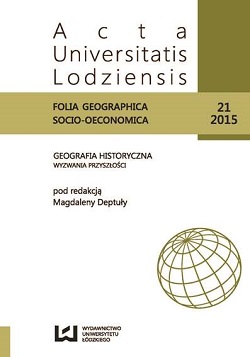Srebrenica: where the war never ended
DOI:
https://doi.org/10.18778/1508-1117.21.08Keywords:
nationalism, genocide, negationism, United NationsAbstract
In Bosnia and Herzegovina changed both by the 1992–1995 war and the Dayton peace which was imposed from outside and which officialised the nationality- -based division of the country, the contrasts that exploded during the conflict are still unsolved. The political forces still base their electoral consent upon nationalistic themes, while the population has lost faith when it comes to a prospective of an economically better future. A good example of this situation is the town of Srebrenica and its surroundings, where Europe’s biggest genocide since WW2 took place. There rest thousands of Muslims killed in July 1995 under the eyes of the UN military forces. The cemetery, a tangible symbol of the horrors which happened at the end of the XX century – not so different from the Nazi concentration camps that were left standing for the whole world to see and for the generations to come to keep as a warning – should inspire absolute respect in anyone. But it does not. This area is inhabited mainly by a Serbian population, and is exposed to insults and abuse from people driving by.
Twenty years from the genocide – which is considered as such by Muslims only and not by Serbs – true peace is still far away, and the nationalities – ex enemies but still rivals – think that only their own dead are to be remembered, while those others are only result of media publicity. Yet if all that can happen in the Third millennia Europe, it means that there is still something wrong in the continent.
References
Battistini F., 2005, Così ho trovato il video choc di Srebrenica, „Corriere della Sera”, Archivio, 6 June 2005, http://archiviostorico.corriere.it
Google Scholar
Branco C.M., 2007, Srebrenica, un abuso di fiducia?, [in:] Kerečki I. (ed.), Il dossier nascosto del “genocidio” di Srebrenica, La Città del Sole, Napoli, p. 71–75.
Google Scholar
Bulajić M., 2007, Non vi è stato un genocidio a Srebrenica, [in:] Kerečki I. (ed.), Il dossier nascosto del “genocidio” di Srebrenica, La Città del Sole, Napoli, p. 77–80.
Google Scholar
Chomsky N., Vltchek A., 2013, On Western Terrorism from Hiroshima to Drone Warfare, Pluto Press, London.
Google Scholar
Corwin P., 2007, La mia testimonianza di alto responsabile dell’ONU sul terreno, [in:] Kerečki I. (ed.), Il dossier nascosto del “genocidio” di Srebrenica, La Città del Sole, Napoli, p. 15–26.
Google Scholar
Dorin A., Jovanović Z., 2012, Srebrenica, come sono andate veramente le cose, Zambon Editore (Srebrenica, wie es wirklich war, Ahriman Verlag, Freiburg).
Google Scholar
Franzinetti G., 2010, Tornare in Bosnia, [in:] Suljagić E., Cartolina dalla fossa. Diario di Srebrenica, Beit, Trieste (Razglednica iz groba, Amsterdam, 2005: De Arbeiderspers), p. 241–250.
Google Scholar
Gaon N., 2012, Fall of Srebrenica. Differences in representations of events by Sarajevo and Belgrade print media, LAP Lambert Academic Publishing, Leipzig.
Google Scholar
Herman E., 2007, L’analisi degli avvenimenti, [in:] Kerečki I. (ed.), Il dossier nascosto del “genocidio” di Srebrenica, La Città del Sole, Napoli, p. 27–52.
Google Scholar
Jean C., 2012, Guerre umanitarie: la militarizzazione dei diritti umani, Dalai Editore, Milano.
Google Scholar
Jovanović N., Hamović D., 2005, Drina, Zavod za udzbenike i nastavna sredstva, Beograd–Srpsko Sarajevo.
Google Scholar
Jukić E.M., 2015, Disputes Delay Publication of Bosnia Census, Balkan Insight, 9 June 2015, ehttp://www.balkaninsight.com/en/article/political-disputes-delay-publication-of-bosnia-s-census-results)
Google Scholar
Kaplan R.D, 1993, Balkan Ghosts: A Journey Through History, St. Martin’s Press, New York.
Google Scholar
Kerečki I. (ed.), 2007, Il dossier nascosto del “genocidio” di Srebrenica, La Città del Sole, Napoli.
Google Scholar
Lallo A., 2011, Il sentiero dei tulipani. Psiconazionalismo in Bosnia Herzegovina, Infinito edizioni, Roma.
Google Scholar
MacKenzie L., 2007, La vera storia di Srebrenica del Generale Lewis MacKenzie, [in:] Kerečki I. (ed.), Il dossier nascosto del “genocidio” di Srebrenica, La Città del Sole, Napoli, p. 67–69.
Google Scholar
Nuhefendić A., 2010, Prefazione, [in:] Suljagić E., Cartolina dalla fossa. Diario di Srebrenica, Beit, Trieste (Razglednica iz groba, Amsterdam, 2005: De Arbeiderspers), p. 11–15.
Google Scholar
Picard M., Zinbo A., 2012, The Long Road to Admission: The Report of the Government of the Republika Srpska, [in:] Delpla I., Bougarel X., Fournel J.-L. (eds.), Investigating Srebrenica. Institutions, Facts, Responsibilities, Berghahn Books, New York–Oxford, p. 131–147.
Google Scholar
DOI: https://doi.org/10.1515/9780857454737-015
Priskil P., 2012, Presentazione, [in:] Dorin A., Jovanović Z. (eds.), Srebrenica, come sono andate veramente le cose, Zambon Editore (Srebrenica, wie es wirklich war, Ahriman Verlag, Freiburg), p. 19–22.
Google Scholar
Rossini A., 2014, Il genocidio del vicino, www.balcanicaucaso.org (online on 18.04.2014).
Google Scholar
Rossini A., 2015a, Srebrenica: il no della Russia, www.balcanicaucaso.org (online on 9.07.2015).
Google Scholar
Rossini A., 2015b, Ritorno a Srebrenica, www.balcanicaucaso.org (online on 8.07.2015).
Google Scholar
Sasso A., 2012, Bosnia: Elezioni amministrative, il trionfo nazionalista e l’incerto destino di Srebrenica, „East Journal. Società politica e cultura dell’Europa orientale”, www.eastjournal.net/bosnia-elezioni-amministrative
Google Scholar
Todorova M., 1997, Imagining the Balkans, Oxford University Press, New York.
Google Scholar
Downloads
Published
How to Cite
Issue
Section
License

This work is licensed under a Creative Commons Attribution-NonCommercial-NoDerivatives 4.0 International License.








